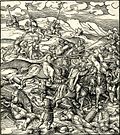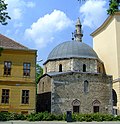Islam in Europe
Islam is the second-largest and fastest-growing religion in Europe.[1] Most Muslim communities in Europe formed recently, but certain areas on the Balkans have a long Muslim history.
Islam entered southern Europe through the invading "Moors" of North Africa in the 8th–10th centuries. Many kingdoms and duchies in Spain, Portugal, Southern Italy and Malta have existed for centuries. After a series of conflicts and wars known as the Reconquista, these areas became Christian. Islam expanded into the Caucasus through the Muslim conquest of Persia in the 7th century. The Ottoman Empire expanded into southeastern Europe; it conquered large parts of the Byzantine Empire in the 14th and 15th centuries. Later, the power of the Ottoman empire faded, and it lost most of its territories in Europe. It collapsed in 1922. The countries of the Balkans still have large populations of native Muslims. Many of these Muslims have become secular.
The term "Muslim Europe" is used for the Muslim-majority countries of Albania, Kosovo and Bosnia and Herzegovina. Transcontinental countries, such as Turkey, Azerbaijan and Kazakhstan have large Muslim populations, as does Russia in the North Caucasus.
In the late 20th and early 21st centuries, large numbers of Muslims immigrated to Western Europe. By 2010, an estimated 44 million Muslims were living in Europe (6%), including an estimated 19 million in the EU (3.8%).[2] They are projected to be 8% by 2030.[source?] They are often the subject of intense discussion and political controversy created by events such as terrorist attacks, the cartoons affair in Denmark, debates over Islamic dress, and ongoing support for populist right-wing parties that view Muslims as a threat to European culture. Such events have also fueled growing debate regarding the topic of Islamophobia, attitudes toward Muslims and the populist right.[3]
The country where most Muslims live in western Europe today is France, where they account for 12.5% of the population. In the European Union, Bulgaria probably has the largest Muslim population, about 15 % of Bulgarians said they were Muslims.
Islam In Europe Media
The King's Mosque in Pristina, Kosovo
Albanian rebels capturing Skopje in August 1912
Battle of Nicopolis in the year 1396
The woodcut by Leonhard Beck, from c. 1515, depicts the Battle of Krbava Field between the army of Croatian nobility and Ottoman akinji.
The Ottoman sultan Suleiman the Magnificent awaits the arrival of the Greek Muslim Grand Vizier Pargalı Ibrahim Pasha at Buda, in 1529.
Medieval Bulgaria, particularly the city of Sofia, was the administrative centre of almost all Ottoman possessions in the Balkans, comprising a region known at the time as Rumelia.
Registration of Christian boys for the tribute in blood. Ottoman miniature painting, 1558.
Court of the Lions, located in the historic citadel of Alhambra in Granada, Spain.
The Moors request permission from King James I of Aragon (13th century)
References
- ↑ Fast-growing Islam winning converts in Western world. CNN. http://edition.cnn.com/WORLD/9704/14/egypt.islam/. Retrieved 7 July 2015.
- ↑ Pew 2011.
- ↑ Goodwin, Matthew J.; Cutts, David; Janta-Lipinski, Laurence (September 2014). "Economic Losers, Protestors, Islamophobes or Xenophobes? Predicting Public Support for a Counter-Jihad Movement". Political Studies. 64: 4–26. doi:10.1111/1467-9248.12159. S2CID 145753701.
Bibliography
- "The Future of the Global Muslim Population: Projections for 2010-2030" (PDF). Pew Research Center. January 2011. Retrieved 14 October 2011.
- Hourani, Albert; Ruthven, Malise (2002). A History of the Arab Peoples. Faber & Faber. ISBN 978-0-571-21591-1.









